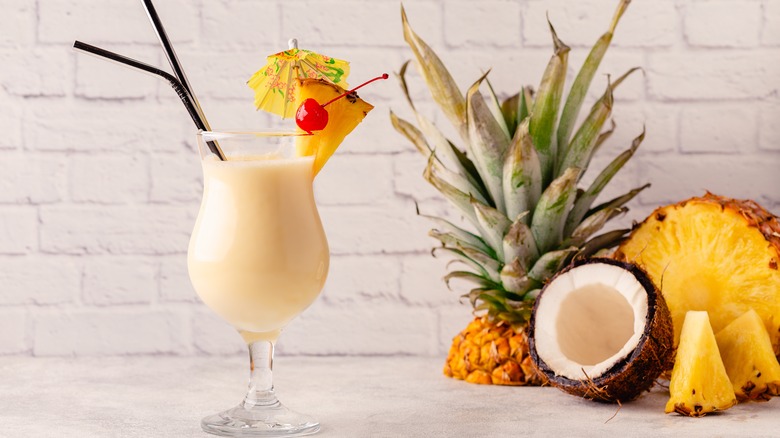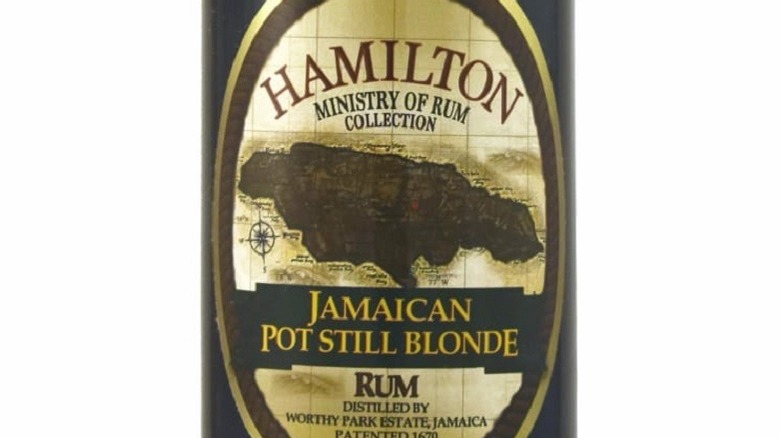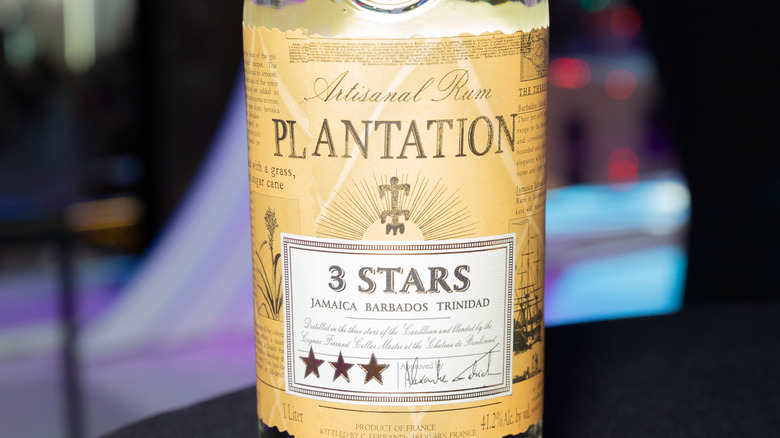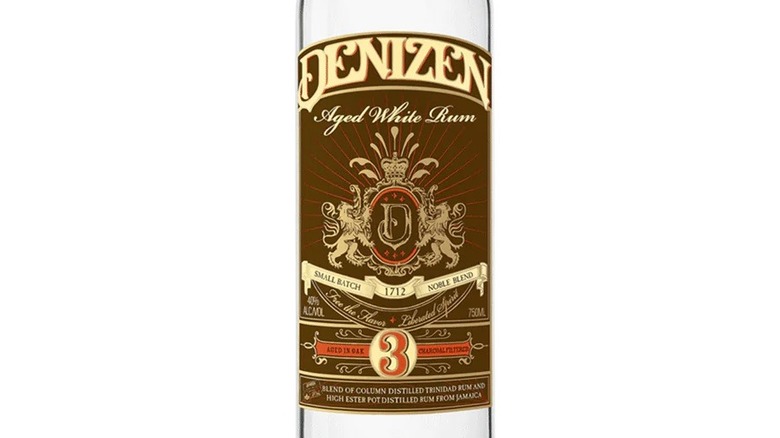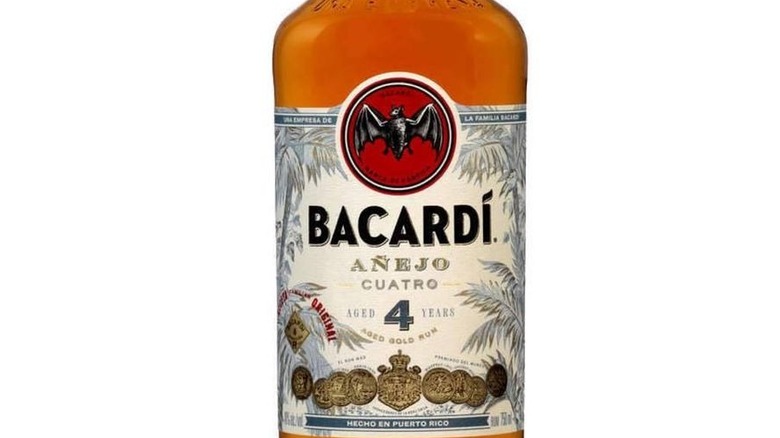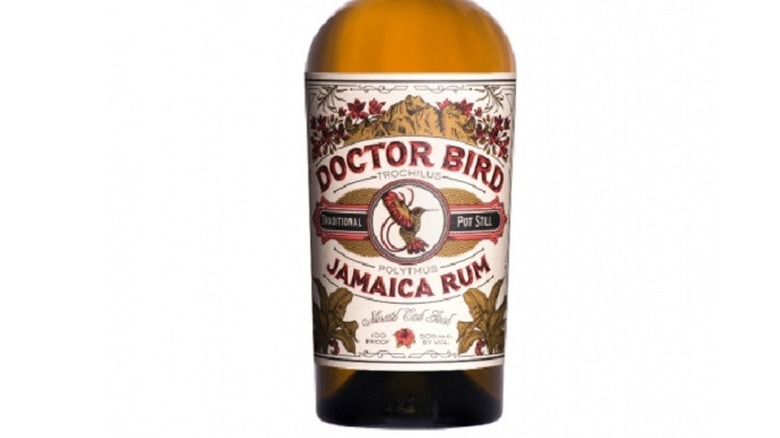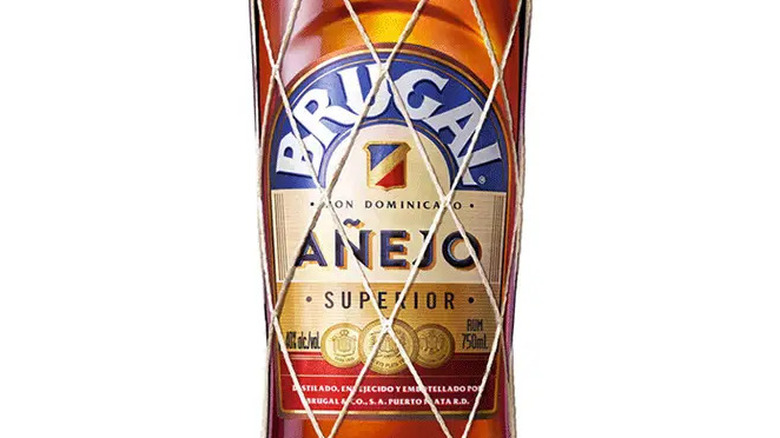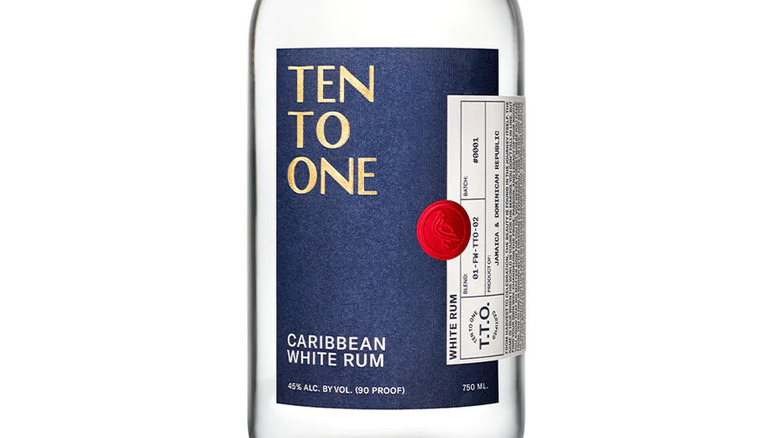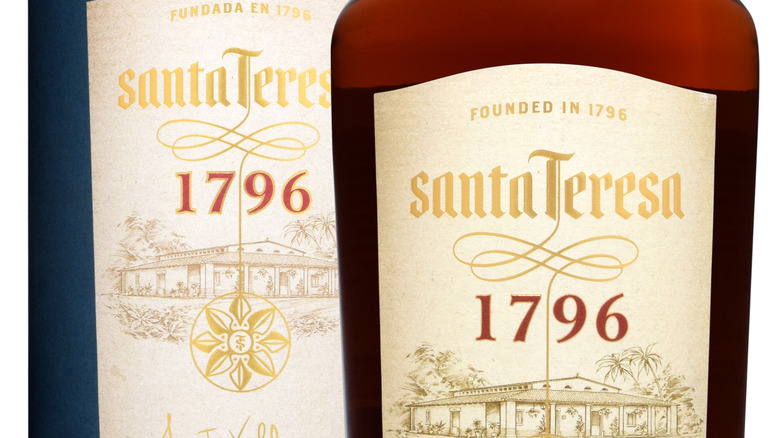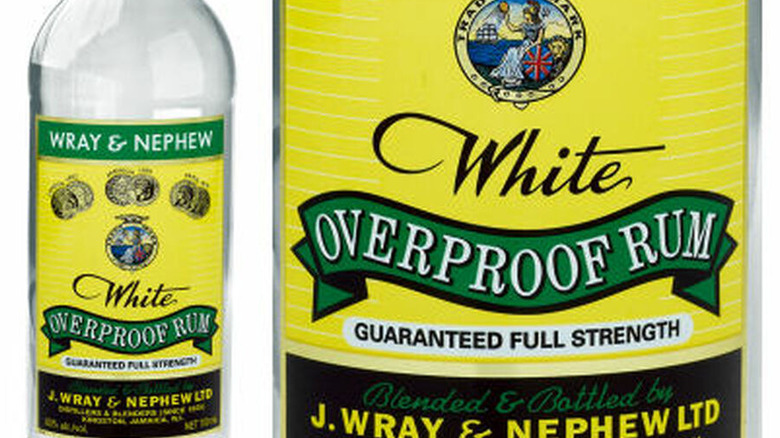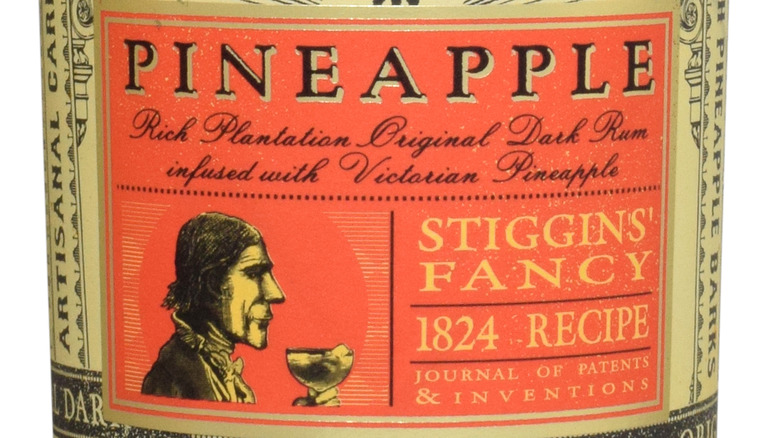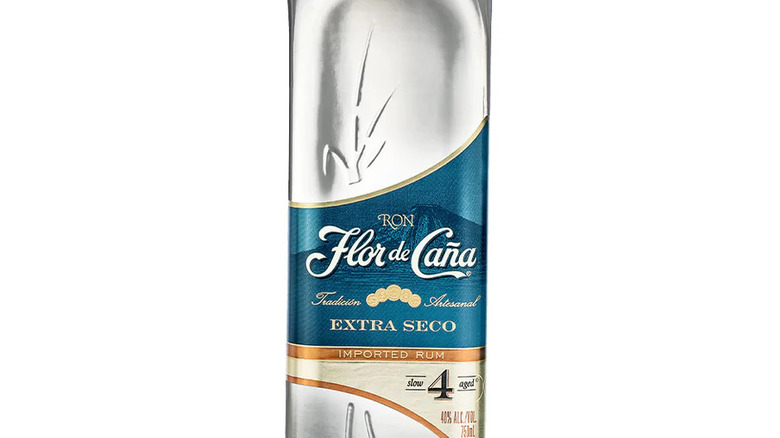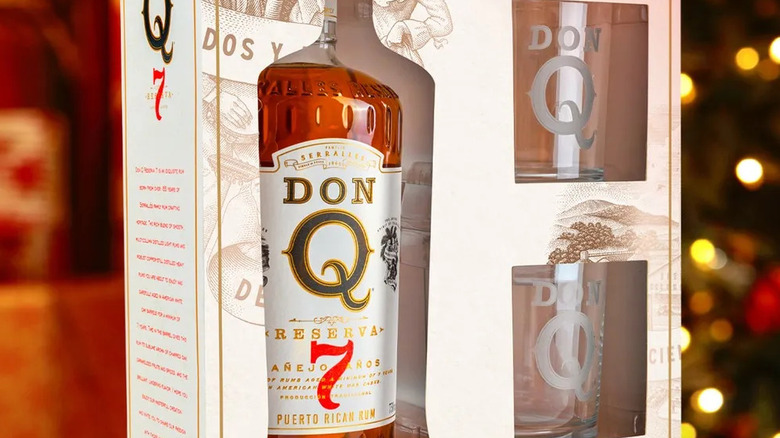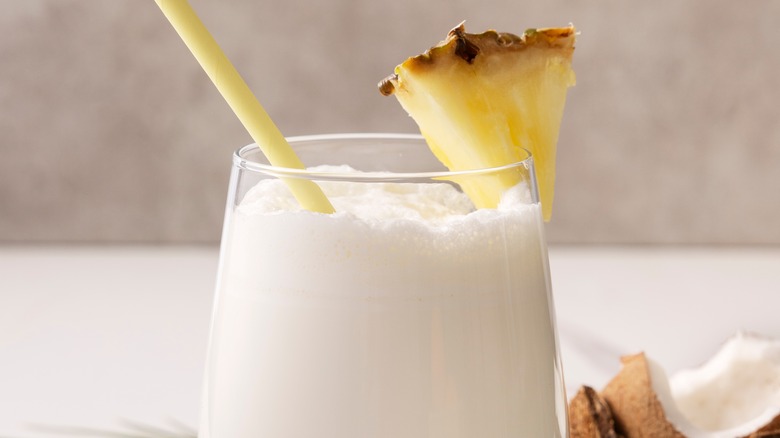12 Best Rums For A Piña Colada, According To An Expert
We'll spare you the bad jokes and get straight to it — piña coladas are delicious. If you enjoy drinking rum, the cocktail is hard to beat, especially when imbibed on the beach with the ocean as your backdrop. A classic piña colada recipe includes a tropical mix of rum, pineapple juice, and coconut cream that tastes like a day in paradise. It's easy to think that since this drink relies on such sweet, fruity flavors, any rum will do the trick. However, there are several styles of rum that vary wildly in flavor, and choosing the right one can take your beachy beverage from good to great.
With so many options out there, we had someone who really knows their rum weigh-in on what to use. Chris Gaspar is a bartender at one of New York City's most celebrated rum bars, appropriately named The Rum House. With an extensive selection of rums, perfectly executed cocktails, and nightly live jazz, it's one of the few bars in Times Square worth fighting the crowds for — especially if you're in the mood for a piña colada.
"I started really working with rum back in 2015 at a small Caribbean bar in Texas. I learned as much as I could about tiki culture and rum classics during my time there. Now, I'm mixing drinks for tourists in Times Square at The Rum House." says Gaspar. With years of expertise under his belt, we picked his brain to find out which rums should be going into your next piña colada.
Hamilton Jamaican Pot Still Blonde
Known for its tell-tale notes of overripe fruit and banana, Jamaican rum is often described as having a distinct element of funk. Though this might not seem like the most appetizing descriptor, connoisseurs relish this unique flavor profile that you won't find in rums from other regions.
Hamilton Jamaican Pot Still Blonde is a perfect representation of how well this style of rum can work to complement the other flavors in a piña colada. It's made from a blend of light and dark rums that are married to create a powerful, aromatic elixir. It's a great foil for ingredients that can taste flat without added depth and complexity from other perceptible flavors.
According to Chris Gaspar, the "approachable notes of funky terroir" in this rum work in tandem with its hints of vanilla and banana to brighten up the creamy coconut in a colada. Though you won't find this rum everywhere, you'd be wise to ask for it as the base for your piña colada when you do.
Plantation 3 Stars
Plantation 3 Stars has a lot going for it. Crafted as an ode to the Caribbean's three primary terroirs (Barbados, Trinidad, and Jamaica), it's a white rum that delivers both balance and richness. The brand claims it's the perfect rum for shaking up daiquiris, but Chris Gaspar assures us it works just as well for top-notch piña coladas.
Offering notes of brown sugar, honey, and baking spices on the nose and biscuit, dark chocolate, and grassy herbs on the palate, it strikes a good balance of being interesting without being intimidating. Gaspar sums this rum up perfectly: "It's approachable — this rum allows the coconut and pineapple to shine." Another great thing about Plantation 3 Stars, according to Gasper, is that it's popular enough that you can find a bottle in most craft cocktail bars, even ones that don't have a large selection of rums on offer.
Denizen 3 Year
This rum is Chris Gaspar's self-proclaimed favorite, so you know it has to be good. Denizen 3 Year is a white rum that starts from a blend of both aged and new Trinidadian rums from the Angostura Distillery. It spends up to five years in bourbon oak barrels and is then combined with three-year-old Jamaican pot still rum in Amsterdam (a city that's been blending rum since the Dutch colonization of the Caribbean in the 1700s).
The brand prides itself on crafting a rum that's more in line with how rum tasted in the past, before the introduction of modern production methods altered many of the spirit's historic flavors. The result is a rum that's full of "hogo," which is a term that rum aficionados use to describe the spirit's signature rich, full characteristics.
"This rum is quite vegetal, with light notes of passionfruit and apricot," says Gaspar. "It makes a bright, fruit-forward piña colada." It won't get lost in the cocktail, and only works to enhance the beverage overall.
Bacardi Añejo Cuatro
There's a reason this is the booze of choice for the Rum House's acclaimed take on the piña colada, "The Escape" (yes, it's named after the Ruppert Holmes yacht rock classic). Most piña coladas rely on white rum as the backbone spirit, but gold rum offers welcome complexity. According to Chris Gaspar, Bacardi Añejo Cuatro is a particular standout due to its "slight oak flavor that provides the presence of alcohol."
You'll know you're drinking booze when you choose this one, which isn't always a bad thing when you're slurping down colada after colada at a beach bar (or as a pick-me-up on a dreary day in the middle of winter). Bacardi Añejo Cuatro also has notes of vanilla, cinnamon, and toffee. It's a great representation of the warming baking spices often found in classic tiki drinks. Aged rum tends to add more depth and complexity, which helps it stand out in a strongly-flavored drink like a piña colada. This rum is aged under the Caribbean sun, and your first sip of a piña colada made with this spirit will make you feel like you've been transported there, too.
Two James Doctor Bird Jamaican Rum
If you want something out of the ordinary that will surprise and expand your palate (in a good way!), reach for Doctor Bird. "This one is for the nerdiest colada," says Chris Gaspar. "This rum brings down the sweetness because it provides citrusy peels and vegetal funk. You'll forget it's a colada and wonder what's in this drink."
Like we said, rums come in a wide range of styles and flavors, and Doctor Bird showcases how much variation can exist between different iterations of the spirit. Named for Jamaica's national bird, the brand pays homage to an important aspect of Jamaican culture. This complex libation is made from pure sugarcane using techniques that date back centuries. The rum is transported to the Two James Distillery in Detroit and aged in barrels that previously held moscatel, a type of sherry wine. The result is a high-ester rum that's colorful, bright, and that doesn't hold back in terms of flavor.
Brugal Añejo
Though piña coladas are supposed to be sweet, they can admittedly sometimes verge on cloying. Opting for a dry rum can make enough of a difference to change the minds of people who think the tropical beverage is too sugary — and make it easier to ask for a second.
Brugal Añejo is a delicious option for anyone who prefers a more balanced drink. You know you're getting a quality bottle since the Dominican Republic-based distillery has been making rum since 1888. "It's a dry rum, perfect for countering sweetness," says Chris Gaspar. "It makes a well-rounded colada, with nips of oak and vanilla."
Providing hints of buttery tannins, Brugal Añejo is aged in American Oak casks for a smooth mouthfeel and depth of flavor. Once you've reached your limit on piña coladas, it works nicely in a light, refreshing highball when paired with soda and a squeeze of lime, as well.
Ten to One White Rum
This rum manages to be simultaneously herbaceous, fresh, fruity, and floral while still remaining balanced and approachable. Ten to One White Rum is made from both column still rum from the Dominican Republic as well as high-ester pot still rum from Jamaica. The goal of the brand is to help consumers reimagine what rum can really be, and to break away from the overplayed narrative of rum being solely associated with pirates, plantations, and spring break. The result is a rum that is exceptionally clean with no added sugars, colors, or flavorings, and you can taste the quality even in a tropical mixed drink.
Since Ten to One is complex and elegant, it makes a standard piña colada taste a bit more refined. "It's slightly fruit-forward, with warm spices and peppery notes," says Chris Gaspar, who recommends adding a floater of vermouth "to bring out more tannic and herbaceous flavors."
Santa Teresa 1796
Hailing from Venezuela, Santa Teresa 1796 is some seriously old rum — and that's a good thing. Its distinct blend of rums is aged for up to 35 years via what is known as the Solera process. Originally used in Spanish sherry making, this complex method entails constantly refilling the barrels each time a bottle is drawn to ensure they never go dry. This means each bottle contains traces of the original rum that was used to initially fill the casks in 1996 (which represents the bicentennial anniversary of the brand's estate and is the year from which this rum takes its name).
The result of having some of the rum's "mother" in each bottle is a nuanced, dry spirit that's rich in both history and flavor. "It has a decent weight in spice, vanilla, and black pepper. You'll get a perfectly balanced cocktail when this rum is used," says Chris Gaspar.
Wray & Nephew Overproof White Rum
Flavor isn't the only thing that can distinguish one rum from another — the alcohol content of various rums can vary significantly as well. The term "overproof" denotes a rum that's at least 50% alcohol by volume. This term is also sometimes referred to as "navy strength," but either way, it means the bottle is particularly intoxicating.
Not only does Wray & Nephew come in at a hefty 63% ABV, but it's also un-aged, so the rum has never been put inside a barrel. This means that it's powerful in both potency and flavor. It's funkier than many white rums, with notes of pineapple, brown sugar, and overripe banana that are easy to detect.
Since it packs such a punch, a little goes a long way. That being said, it works well for piña coladas with a split base or as a floater to add depth of flavor and a little extra kick.
Plantation Stiggins' Fancy Pineapple Rum
What works well in a pineapple-forward cocktail? As it turns out, more pineapple. If you're a cocktail purist, don't let the idea of an infused rum be off-putting. Plantation Stiggins' Fancy Pineapple Rum is actually an extremely respectable option. In fact, it was originally created for the 2014 Tale of the Cocktail Apprentice Program to honor bartenders' hard work. Though slated as a one-time release, the rum was so welcomed that it soon became a regular offering.
This rum is made by infusing and then further distilling Plantation 3 Stars Rum with pineapple rinds. Then, the infused rum is blended with Plantation Original Dark Rum, that's been separately infused with pineapple flesh. The result is a rum with sophisticated, grown-up pineapple flavor, as well as warm notes of smoke and spice.
Don't confuse this rum with other artificially flavored, chemical-laden flavored products. Plantation Stiggins' Fancy Pineapple Rum is much more complex and layered, and it works to really brighten the pineapple flavor in a piña colada. It's also a key ingredient in our pineapple daiquiri recipe, but it works equally well if you want to add coconut to the equation.
Flor de Caña 4 Extra Seco
Sometimes you don't want the rum to be the star of the show in your piña colada. When you want to let the coconut and pineapple do the talking, opt for Flor de Caña 4 Extra Seco.
It's a light-bodied rum that's so smooth and subtle, you might forget your cocktail has booze at all. It also has zero added sugar, so you don't have to worry about your beverage tasting too sweet. This rum is light, bright, and refreshing, and is a perfect alternative to heavy, spice-laden choices when you want to keep things refreshing.
White chocolate and orange dominate the palate, with notes of vanilla and almond on the nose. Flor de Caña 4 Extra Seco is a crowd-pleaser, and you'd be hard-pressed to find someone who doesn't like a piña colada made with this rum, which also happens to be Fair Trade Certified, carbon-neutral, and sustainably produced. In other words, you can feel good about drinking it in your next tropical adult beverage.
Don Q Gran Reserva 7
As with many cocktails, the history of the piña colada is long and somewhat complicated. However, the cocktail as we know it today originated in Puerto Rico in 1954, when bartender Ramon "Monchito" Marrero created it at the Caribe Hilton Hotel's Beachcomber Bar in San Juan using newly available advancements in coconut cream production (via Forbes).
According to the brand's website, Don Q was the rum Mochito reached for when he first created his cocktail legacy. Though the original recipe calls for Don Q Gold, Chris Gaspar recommends opting for the Gran Reserva 7.
"It's bold, with hints of tobacco and dried fruit," says Gaspar. The combination adds a richness and punch that elevates the original specs into something more layered and unique. The Gran Reserva 7 varietal is aged for a minimum of seven years in White American Oak barrels and has a round, robust flavor. It's versatile and another prime example of how an añejo rum can help a piña colada shine.
Methodology
Picking the best rums for pina colada isn't a simple choice. To find the selections for this article, we talked with expert Chris Gaspar, a resident bartender of the New York City-based bar The Rum House. Throughout the conversation, Gaspar presented us with some of the many qualifying factors that he uses to pick quality rums for coladas.
When choosing rums for piña coladas, Gaspar stressed that he prefers spirits that allow for balance in the drink. He considers the terroir of the region from which the rum is sourced, a factor that has an outsized effect on the overall characteristics of the spirit. As was clear from his explanations, quality-made rums develop a range of traits, and he recommends plenty of tastings in order to suss out whether a rum is sweet, vegetal, funky, or fruit-forward. While the rums he chose do have bold personalities, Gaspar was sure to note that the best rums for this cocktail are ones that work in unison with pineapple and coconut rather than masking any of the tropical accents that this tiki drink is known for.
